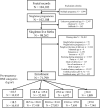Gestational weight gain and foetal acidosis in vaginal and caesarean deliveries: The Japan Environment and Children's Study
- PMID: 33230184
- PMCID: PMC7683683
- DOI: 10.1038/s41598-020-77429-9
Gestational weight gain and foetal acidosis in vaginal and caesarean deliveries: The Japan Environment and Children's Study
Erratum in
-
Author Correction: Gestational weight gain and foetal acidosis in vaginal and caesarean deliveries: The Japan Environment and Children's Study.Sci Rep. 2021 Apr 20;11(1):8906. doi: 10.1038/s41598-021-88092-z. Sci Rep. 2021. PMID: 33879828 Free PMC article. No abstract available.
Abstract
Inappropriate gestational weight gain (GWG), either above or below the recommended values, has been associated with an increased risk of adverse obstetric outcomes. To evaluate the risks of GWG for foetal acidosis according to pre-pregnancy body mass index (BMI) and mode of delivery, we analysed women with singleton pregnancies between 2011 and 2014 in the Japan Environment and Children's Study. Participants (n = 71,799) were categorised according to pre-pregnancy BMI. GWG was categorised into insufficient, appropriate, or excessive. Foetal acidosis was defined as umbilical artery pH (UmA-pH) < 7.20 or < 7.10. Multiple logistic regressions were performed for each BMI category to identify the risks of GWG for foetal acidosis, accounting for the mode of delivery. Excessive GWG was significantly associated with increased foetal acidosis in overweight women and in women whose pre-pregnancy BMI was 23.0-25.0 kg/m2 especially in those with vaginal deliveries. Conversely, excessive GWG was not significantly associated with increased foetal acidosis in obese women and in women whose pre-pregnancy BMI was ≥ 25.0 kg/m2.
Conflict of interest statement
The authors declare no competing interests.
Similar articles
-
Maternal pre-pregnancy body mass index and foetal acidosis in vaginal and caesarean deliveries: The Japan Environment and Children's Study.Sci Rep. 2021 Feb 23;11(1):4350. doi: 10.1038/s41598-020-79178-1. Sci Rep. 2021. PMID: 33623113 Free PMC article.
-
[Relationship between the risk of emergency cesarean section for nullipara with the prepregnancy body mass index or gestational weight gain].Zhonghua Fu Chan Ke Za Zhi. 2017 Nov 25;52(11):757-764. doi: 10.3760/cma.j.issn.0529-567X.2017.11.008. Zhonghua Fu Chan Ke Za Zhi. 2017. PMID: 29179271 Chinese.
-
Lack of concern about body image and health during pregnancy linked to excessive gestational weight gain and small-for-gestational-age deliveries: the Japan Environment and Children's Study.BMC Pregnancy Childbirth. 2021 May 21;21(1):396. doi: 10.1186/s12884-021-03827-0. BMC Pregnancy Childbirth. 2021. PMID: 34020606 Free PMC article.
-
[Maternal pre-pregnancy body mass index and gestational weight gain with preschool children's overweight and obesity].Zhonghua Yu Fang Yi Xue Za Zhi. 2016 Feb;50(2):123-8. doi: 10.3760/cma.j.issn.0253-9624.2016.02.005. Zhonghua Yu Fang Yi Xue Za Zhi. 2016. PMID: 26926719 Chinese.
-
Exposure to heavy metals modifies optimal gestational weight gain: A large nationally representative cohort of the Japan Environment and Children's Study.Environ Int. 2021 Jan;146:106276. doi: 10.1016/j.envint.2020.106276. Epub 2020 Nov 29. Environ Int. 2021. PMID: 33264735
Cited by
-
Maternal obesity: Perinatal implications.SAGE Open Med. 2023 May 29;11:20503121231176128. doi: 10.1177/20503121231176128. eCollection 2023. SAGE Open Med. 2023. PMID: 37275842 Free PMC article. Review.
-
Gestational weight gain as a risk factor for dystocia during first delivery: a multicenter retrospective cohort study in Japan.BMC Pregnancy Childbirth. 2022 Sep 23;22(1):728. doi: 10.1186/s12884-022-05055-6. BMC Pregnancy Childbirth. 2022. PMID: 36151536 Free PMC article.
-
Association of labour duration in spontaneous deliveries with low neonatal Apgar scores and foetal acidosis: the Japan Environment and Children's Study.Sci Rep. 2022 Dec 13;12(1):21519. doi: 10.1038/s41598-022-24359-3. Sci Rep. 2022. PMID: 36513654 Free PMC article.
-
Maternal pre-pregnancy body mass index and foetal acidosis in vaginal and caesarean deliveries: The Japan Environment and Children's Study.Sci Rep. 2021 Feb 23;11(1):4350. doi: 10.1038/s41598-020-79178-1. Sci Rep. 2021. PMID: 33623113 Free PMC article.
References
-
- Institute of Medicine (US) Committee on Nutritional Status During Pregnancy and Lactation . Nutrition During Pregnancy: Part I: Weight Gain, Part II Nutrient Supplements. Washington, DC: National Academies Press; 1990. - PubMed
-
- Institute of Medicine (US), National Research Council (US) Committee to reexamine IOM pregnancy weight guidelines. In: Rasmussen K, Yaktine AL, editors. Weight Gain During Pregnancy: Reexamining the Guidelines. Washington, DC: National Academies Press; 2009. - PubMed
-
- Physical status: The use and interpretation of anthropometry: Report of a WHO Expert Committee. World Health Organ. Tech. Rep. Ser.854, 1–452 (1995). - PubMed
Publication types
MeSH terms
LinkOut - more resources
Full Text Sources
Medical


